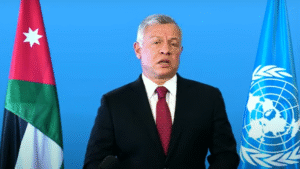Iran threw its affiliate in Yemen, the Shia “Ansar Allah” organization of the Houthis in Yemen, into the battle against Israel.
The Houthis, who are well equipped with advanced weapons, launched, a few days ago, 3 cruise missiles and 9 drones towards Israel, the American missile destroyer USS Carney staying in the Red Sea intercepted the missiles and drones from Yemen, according to security sources in Israel, one missile was intercepted by Saudi Arabia.
The Houthis officially took responsibility for the attack on Israel and despite its failure they continue to threaten Israel. Ahmed Hamed, director of the presidential office in Sana’a in Yemen, announced on the Houthis’ television channel on October 25th that “the Palestinians will not be alone in the battle against Israel.”
He explained that the Houthis’ support for “Palestine” is a religious position from the Koran that has respect and that they will not give it up even if the whole world gives it up.
Salim Al-Ma’als, a member of the political bureau of the Ansar Allah organization, said that “Yemen is ready for a confrontation on more than one front.”
Security officials in Israel estimate that the Houthis’ threats in Yemen are serious and that further attacks on Israel are expected from their side as soon as the IDF’s ground operation in the Gaza Strip begins.
The IDF is well coordinated with the American army and is also preparing to a new front from Yemen.
The attack by the Houthis on Israel did not surprise the IDF, it was expected as part of the “unification of fronts” policy led by Iran against Israel.
Last week, Iran began a war of attrition against Israel on all possible fronts in an attempt to prevent it from embarking on a major ground operation in the Gaza Strip aimed at toppling the rule of Hamas and destroying the organization’s military infrastructure in the Strip.
Israel is within the range of the Houthis’ cruise missiles and drones in Yemen, they can reach a range of more than 2000 km, the Houthis already announced about two years ago that they had prepared a target bank for Israel.
Iran has been preparing its affiliates in the Middle East for a campaign against Israel for several years. The person who devised the stranglehold strategy on Israel was Qassem Soleimani, commander of the “Quds” force of the Iranian Revolutionary Guards who was assassinated in Iraq by the United States and who continues it is his successor, General Ismail Kaani.
The Houthis in Yemen also have ballistic missiles that fly at a greater speed than the cruise missiles towards the target, but Israel is also prepared for this scenario. These missiles and drones are locally produced in Yemen using Iranian technology, the Houthis have a lot of experience in launching missiles and drones and in recent years since the war in Yemen broke out they have launched hundreds of missiles and drones towards Saudi Arabia and the United Arab Emirates.
This time the missiles and drones launched from Yemen to Israel were intercepted by the American military, but this does not mean that the IDF will not respond itself in the future to any attack by the Houthis.
Despite the great distance from Israel, the long arm of the Israeli Air Force can also reach Yemen.
Israel also has several means to defend against missiles and drones launched at it from Yemen, it can intercept them with fighter jets and with the air defense systems “David’s Slingshot” and “Iron Dome”.
The Houthis have a long account with Israel, they blame it that it provided drones to Saudi Arabia and the United Arab Emirates to attack them in Yemen.
One of Israel’s greatest challenges, from a security point of view, in the longer term, after the end of the war in the Gaza Strip, will be the danger to the ships of the Israeli merchant fleet that sail in the Red Sea and in the Bab Al-Mandab area, the Houthis may start a war of attrition against Israel and try to damage these ships.
Israel will have to seek the help of US Navy in the area to ensure the safety of its ships.




